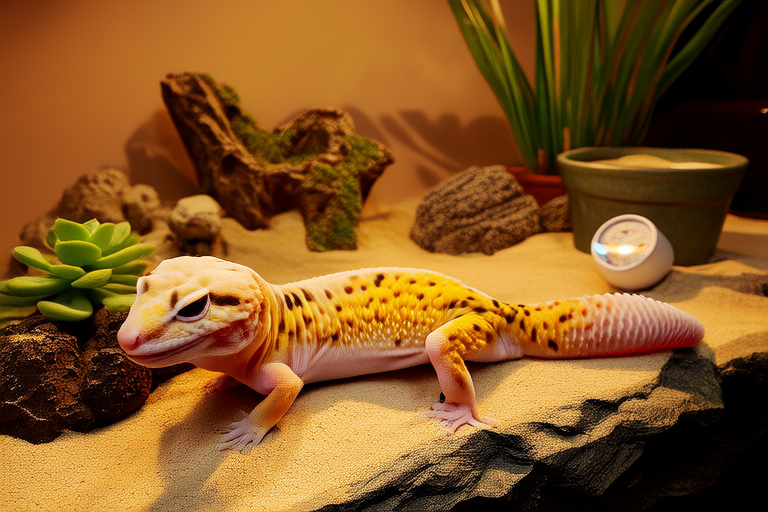How to Set Up the Perfect Habitat for Your Leopard Gecko
Welcome to the world of leopard geckos! These fascinating creatures are popular pets among reptile enthusiasts due to their docile nature and relatively low maintenance requirements. Setting up the perfect habitat for your leopard gecko is crucial for its health and happiness. This comprehensive guide will walk you through the essential components of a well-designed enclosure, from temperature gradients and appropriate substrate to hiding spots and lighting requirements.
Understanding Leopard Geckos
Leopard geckos are native to the arid regions of Afghanistan, Pakistan, India, and parts of Iran. They are nocturnal animals, meaning they are most active during the night. In captivity, they thrive when provided with an environment that mimics their natural habitat. A well-set-up habitat not only ensures their physical health but also their psychological well-being.
Essential Components of a Leopard Gecko’s Habitat
Temperature Gradients
Creating a proper thermal gradient is vital for your leopard gecko’s health. Leopard geckos are ectothermic, which means they rely on external sources to regulate their body temperature. The enclosure should have a warm end and a cool end to allow the gecko to thermoregulate effectively.
- Basking Spot: Maintain a basking spot of around 90°F (32°C) at one end of the tank. Use a heat lamp or ceramic heater for this purpose.
- Cool End: The cooler side should be approximately 75-80°F (24-27°C). Ensure there’s no direct heat source here.
- Nighttime Temperature: Lower temperatures are acceptable at night, ranging between 65-75°F (18-24°C).
Appropriate Substrate
The substrate you choose plays a significant role in maintaining hygiene and preventing impaction. Avoid substrates that can cause impaction, such as sand, crushed walnut shells, or corn cob bedding. Opt for safer alternatives:
- Paper Towels: Simple and effective for baby geckos or during shedding periods.
- Reptile Carpet: Reusable and easy to clean, though it may not look as natural.
- Eco-Substrate: Made from coconut fiber, it’s safe and retains moisture well.
Hiding Spots
Leopard geckos are shy and require hiding spots to feel secure. Provide multiple hideouts throughout the enclosure:
- Plastic Hides: These are durable and easy to clean.
- Logs: Naturalistic and appealing for the gecko.
- Caves: Various shapes and sizes available for different preferences.
Ensure each hide is spacious enough for the gecko to turn around comfortably and has an entrance and exit.
Lighting Requirements
Leopard geckos do not require UVB lighting as they synthesize vitamin D3 through their diet. However, providing a 12-hour light cycle can help maintain a day-night rhythm and enhance the gecko’s mood:
- Daylight Bulbs: Use incandescent or LED bulbs that mimic natural daylight.
- Nocturnal Lighting: For viewing purposes, consider using red or blue bulbs that won’t disturb the gecko’s sleep.
Suitable Tank Mates
Leopard geckos are solitary creatures and generally do not interact well with other animals. Housing multiple geckos together can lead to stress, fighting, and even injury. It’s best to keep them singly unless breeding, under controlled conditions.
Maintaining Hygiene and Regular Cleaning Schedules
A clean habitat is crucial for your leopard gecko’s health. Follow these guidelines to ensure a hygienic environment:
- Spot Cleaning: Remove feces and uneaten food daily.
- Deep Cleaning: Every two weeks, remove all decorations, substrate, and water dishes. Clean the tank thoroughly with a reptile-safe disinfectant, rinse well, and let dry before replacing everything.
- Water Bowl: Change the water daily and clean the bowl regularly.
Regular cleaning helps prevent bacterial growth and keeps your gecko healthy.
Tips for Beginners
If you’re new to keeping leopard geckos, here are some helpful tips:
- Research Thoroughly: Understand the species’ needs before bringing one home.
- Start with the Essentials: Invest in a high-quality enclosure, heating equipment, and appropriate substrate.
- Consult Experts: Reach out to experienced breeders or veterinarians for advice.
- Patience: Give your gecko time to acclimate to its new environment.
Safety Measures
To ensure the well-being of your leopard gecko, follow these safety measures:
- Secure Enclosure: Ensure the tank lid is tightly secured to prevent escape.
- Handle with Care: Always support the gecko’s entire body when handling.
- Monitor Health: Watch for signs of illness, such as lethargy, loss of appetite, or unusual behavior.
- Veterinary Care: Schedule regular check-ups with a reptile-savvy veterinarian.
Conclusion
Setting up the perfect habitat for your leopard gecko involves understanding its natural environment and providing the necessary elements for its health and happiness. By creating a balanced thermal gradient, choosing the right substrate, offering ample hiding spots, and maintaining hygiene, you’ll ensure your gecko lives a long and healthy life. Remember, every gecko is unique, so observe its behavior and adjust its environment accordingly. With the right care and attention, your leopard gecko will thrive in its new home.
